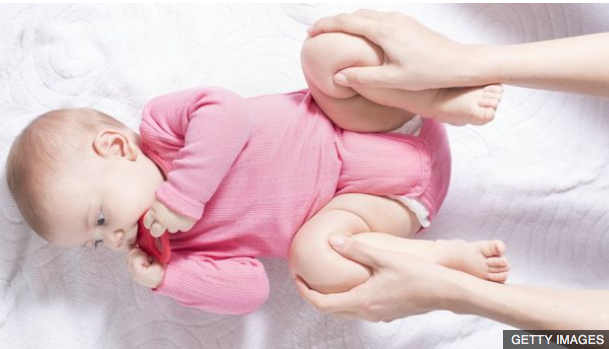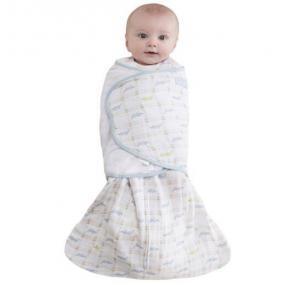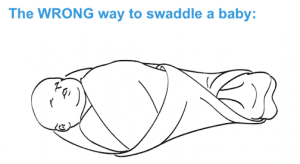
Parents around the world use swaddling as a way to comfort fussy babies, reduce crying, and develop more settled sleep patterns. Often when we see babies getting ready for bedtime and being swaddled, their bodies are tightly wrapped in a cloth, sheet, light blanket, or a specialty swaddle product. This is where a potential hidden danger exists. Not allowing the hips and legs to move freely can promote the most common birth abnormality, hip dysplasia. Because this condition can be challenging to detect, even by a trained physician, it’s important to know about safe swaddling before using a swaddle for naptime or sleeping for the night.
What is hip dysplasia and what does swaddling have to do with it?
Loose hip joints are the most common abnormality in newborn infants and affect approximately one in ten babies. While this may be difficult to detect and usually goes away during the first few weeks of life, loose ligaments around the hip can lead to complete hip dislocation, continuing joint instability, or poor development of the hip socket. This range of hip abnormalities is called Hip Dysplasia.
If left undetected, hip dysplasia in children can result in a limited range of motion, consistent pain, swayback which is a painless but exaggerated waddling limp or leg length discrepancy, hip click or “pops”, among other issues. When not treated, adults and adolescents can experience a range of pain when walking, running, sleeping, limping, and a sensation of catching, snapping, popping, or locking that is usually painful.
“Improper swaddling may lead to hip dysplasia or developmental dysplasia of the hip. When in the womb the baby’s legs are in a fetal position with the legs bent up and across each other. Sudden straightening of the legs to a standing position can loosen the joints and damage the soft cartilage of the socket.” According to Dr. Charles Price, Director of the International Hip Dysplasia Institute, “Hip dysplasia often goes untreated because it can be difficult to detect. Hip dysplasia is often curable without surgery if discovered within the first six months of life.”
How is Hip Dysplasia Detected?
You may remember seeing your newborn being examined as if he or she was a frog. The pediatrician pumps those little legs, and many may think the doctor is checking to see if your baby’s knees work. Not quite…she is checking your baby’s hips which are not fully formed at birth and must be examined in the early months to ensure healthy development.

Why all this concern over hips? Won’t they just grow as the baby does? The simple answer is yes they will grow along with the rest of baby’s body; however, this part of baby’s body must be monitored to ensure the hips are developing correctly and with the flexibility necessary to lead a healthy and pain-free life.
What Can a Parent Do to Protect Their Child?
The best thing new and expectant parents can do is to be aware of the warning signs and/or risk factors for hip dysplasia. A recent study in the UK revealed that the current system of checking newborns is failing to result in too many late diagnoses leading to surgery.
If your baby exhibits one or more, you may want to ask for an ultrasound which is the best way to confirm if the condition exists:
- breech birth
- family history
- firstborn female
- reduced fluid volume in the womb
- neck tightness
- foot abnormality from compression in the womb
How to Safely Swaddle Your Baby Before Sleep:
 Since baby’s hips are not fully formed at birth, parents must take extra care when selecting baby products that can affect hip development. Infant swaddles, which recreate the intimacy of the womb by wrapping baby’s body in a snug manner, must be loose on the bottom so baby can kick and move his legs freely.
Since baby’s hips are not fully formed at birth, parents must take extra care when selecting baby products that can affect hip development. Infant swaddles, which recreate the intimacy of the womb by wrapping baby’s body in a snug manner, must be loose on the bottom so baby can kick and move his legs freely.
There are many ways to swaddle babies by using blankets or commercial products designed for swaddling. In order for swaddling to allow healthy hip development, the legs should be able to bend up and out at the hips. This position allows for the natural development of the hip joints.
 The baby’s legs should not be tightly wrapped straight down and pressed together. Swaddling infants with the hips and knees in an extended position may increase the risk of hip dysplasia and dislocation.
The baby’s legs should not be tightly wrapped straight down and pressed together. Swaddling infants with the hips and knees in an extended position may increase the risk of hip dysplasia and dislocation.
The IHDI has developed a video to teach you how to swaddle your baby properly in order to keep your baby’s hips healthy and safe.
Hip Dysplasia is no laughing matter: how a comedian put it on everyone’s radar
Larry the Cable Guy is best known as one of the leading comedians in the country along with being a Grammy nominee and Billboard award winner. He also started the Git-R-Done Foundation which supports various charities including the International Hip Dysplasia Institute which he co-founded with Dr. Price. Why his interest in hip dysplasia? His own son Wyatt was diagnosed with hip dysplasia at a time when there was no resource of information on the condition for parents to access. He eventually met Dr. Price whom he credits with curing his son without surgery. Throughout the process, Larry and his wife Cara felt lost trying to educate themselves on the condition. Today the International Hip Dysplasia Institute is the leading resource on hip dysplasia to improve the health and quality of life of those afflicted with hip dysplasia. The Institute also brings together medical centers worldwide to promote the prevention, diagnosis, and treatment of hip dysplasia.
Charles T. Price, M.D. is Director of the International Hip Dysplasia Institute and Director of Pediatric Orthopaedic Education at Orlando Health. He is internationally known for his clinical and academic achievements including numerous scientific publications and book chapters on a variety of subjects. He has developed and chaired the International Pediatric Orthopedic Society meeting since its inception 10 years ago.








